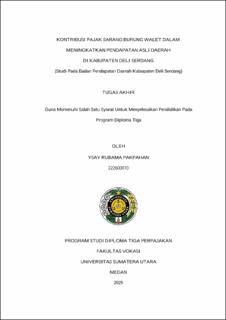| dc.description.abstract | One of the sources of revenue in the Regional Budget (APBD) comes from
Regional Original Income (PAD), which is primarily derived from local taxes.
Local taxes serve as a crucial component in increasing regional income, as higher
regional revenues enable local governments to better meet the needs of their
respective regions. Among the various types of local tax revenues, one is the
Swallow Bird Nest Tax.
This study aims to examine the implementation and procedures of Swallow
Bird Nest Tax collection, analyze its contribution to the Regional Original Income
(PAD), identify the obstacles encountered, and assess the efforts made by the
Regional Income Board (Bapenda) of Deli Serdang Regency in optimizing the tax
collection.
This research adopts a descriptive qualitative approach, with data
collection techniques including interviews, observations, document analysis, and
literature review.
The findings indicate that the collection of the Swallow Bird Nest Tax is
carried out through several stages, including registration as a Regional Taxpayer,
submission of the Regional Tax Return (SPTPD), calculation of payable tax,
payment, and submission of payment proof. However, the contribution of this tax to
the PAD during the period 2021–2024 remains significantly low, consistently below
0.01% per year. The main obstacles identified include difficulties in identifying
taxpayers, high levels of confidentiality among business owners, limited voluntary
reporting, and challenges in field supervision. Despite the efforts undertaken by
Bapenda, such as cooperation with the Quarantine Agency and the Prosecutor’s
Office, the outcomes have not yet been optimal. Therefore, a more integrated
strategy and increased taxpayer awareness are necessary to maximize revenue
from this sector and enhance its actual contribution to PAD. | en_US |


